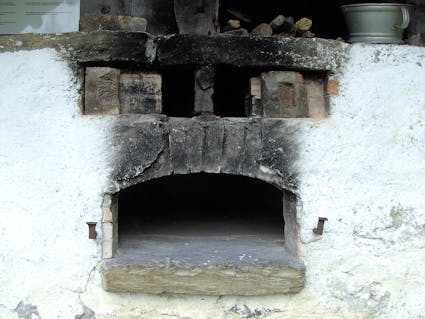1032 – Drying oven from Brienzwiler, Berne, 18th Century
Ovens for baking and drying can be integrated in dwellings. They often stood apart as a separate building isolated from the house to obviate the danger of fire.

Separatists
Ovens for baking and drying can be integrated in dwellings, as in the farmhouse from La Chaux-de-Fonds (111). They often stood apart as a separate building isolated from the house to obviate the danger of fire. The 18th century oven from Brienzwiler is of this kind. They were called in dialect "Derrofen". The oven stands opposite the chapel from Turtig/Raron (1131) and already existed on the land of the Ballenberg Open-Air Museum before the opening.

Practical Buildings
The architecture of the building is visible at first sight: a massive body of masonry surrounds the oven space. The shingled roof extends over the front of the oven so that people tending the oven are under cover. Their tools lie on stone slabs above the oven vault in a space under the roof slope. Here there are pokers, shovels for firing the oven, cleaning rags for wiping the floor and whatnot.

Little Power Plant
A small but important element is visible above the firedoor: the apertures of the draft flues which can be dampered by movable clay tiles. This regulates the energy. This in turn stores energy in the form of dried apple and pear slices, good for supplying strength in the winter. The big drying oven from Alpnachstad (713) demonstrates more clearly the concept of such structures.

Ballenberg
Swiss Open-Air Museum
Museumsstrasse 100
CH-3858 Hofstetten bei Brienz
Company holidays
24 December 2025 to 11 January 2026
Opening hours Administration
3 November 2025 to 8 April 2026
From Monday to Friday
8.30 am to 11.30 am
1.30 pm to 4.30 pm
Opening hours
9 April to 1 November 2026
10 am to 5 pm daily